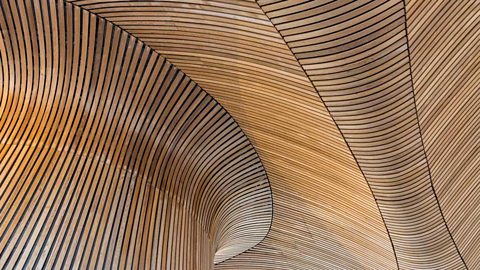Technical considerations
Aesthetics - colour, texture, surface, shape, form
The aestheticsThe beauty of something are what make the piece work effectively within its surroundings.
| Aesthetic | Description |
| Colour | The architecture may need to blend into the surroundings or it might stand out. In landscape architecture, the colour of plants and flowers impacts the environment. |
| Texture | The material. Architecture may be covered with climbing plants to blend in with the landscape. Wood, metal, plastic, glass and any other material may be used for aesthetic reasons and to make sure the piece will relate to its surroundings. |
| Surface | Surfaces can appear rough or smooth. Architects and artists can use materials to imitate other surfaces - this could be for cost, practicality and functionality. |
| Shape and form | Any piece of architecture will be designed to either complement or contrast with its surroundings. Pieces can be curved and fluid or they can be sharp and angular. |
| Aesthetic | Colour |
|---|---|
| Description | The architecture may need to blend into the surroundings or it might stand out. In landscape architecture, the colour of plants and flowers impacts the environment. |
| Aesthetic | Texture |
|---|---|
| Description | The material. Architecture may be covered with climbing plants to blend in with the landscape. Wood, metal, plastic, glass and any other material may be used for aesthetic reasons and to make sure the piece will relate to its surroundings. |
| Aesthetic | Surface |
|---|---|
| Description | Surfaces can appear rough or smooth. Architects and artists can use materials to imitate other surfaces - this could be for cost, practicality and functionality. |
| Aesthetic | Shape and form |
|---|---|
| Description | Any piece of architecture will be designed to either complement or contrast with its surroundings. Pieces can be curved and fluid or they can be sharp and angular. |
Dimensions ÔÇô scale and measurements

During construction, precise measurements are carried out to make sure that the structure is architecturally sound and safe
ThereÔÇÖs usually no room for error with measurements and dimensions. All designs must be accurate.
Materials
The materials used determine the visual aesthetic - they control the shape and form, the colour, texture and surfaces.
- Metal is a commonly used material in architecture. It is strong and can be made into exact shapes and sizes, and easily moved and attached.
- Wood is cheaper than metal and can be easily cut and assembled.
- Glass is used to let light into the space or for decoration. It is relatively cheap and easy to cut.
- Concrete is cheap and durable. The shapes often have to be formed before being put in place.
- Plastic is cheap and easy to cut, form and construct.
Click through the slideshow for examples of different building materials:

Image caption, The natural colour of this wood means it doesnÔÇÖt need to be decorated to look beautiful.
Image caption, Concrete can be smoothed, polished and left unpainted to give an industrial look.
1 of 3
End of image gallery